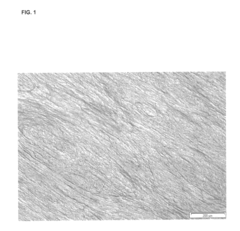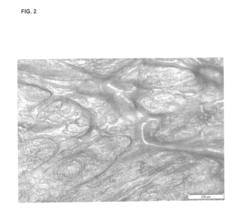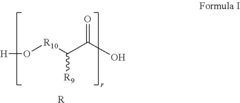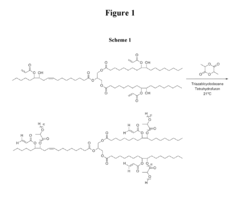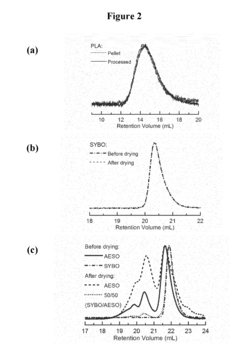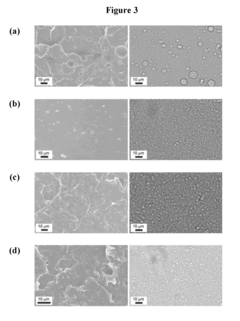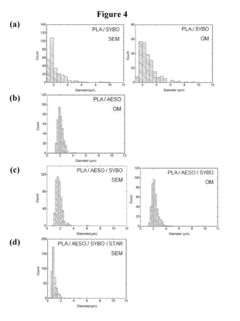PLA Compatibility with Additives for Custom Properties
JUN 25, 20258 MIN READ
Generate Your Research Report Instantly with AI Agent
Patsnap Eureka helps you evaluate technical feasibility & market potential.
PLA Additive Research Background and Objectives
Polylactic acid (PLA) has emerged as a prominent biodegradable polymer in recent years, gaining significant attention due to its eco-friendly properties and versatile applications. The development of PLA-based materials has been driven by the growing demand for sustainable alternatives to conventional plastics across various industries. However, despite its numerous advantages, PLA often falls short in meeting specific performance requirements for certain applications.
The evolution of PLA technology has been marked by continuous efforts to enhance its properties and expand its potential uses. Initially, PLA was primarily utilized in medical applications due to its biocompatibility and biodegradability. Over time, researchers and industry professionals have recognized the need to improve PLA's mechanical, thermal, and barrier properties to broaden its applicability in sectors such as packaging, automotive, and consumer goods.
The primary objective of research on PLA compatibility with additives is to address the inherent limitations of pure PLA while maintaining its core benefits. By incorporating various additives, researchers aim to tailor PLA's properties to meet specific application requirements. This includes improving its heat resistance, impact strength, flexibility, and barrier properties, among others.
One of the key trends in PLA additive research is the exploration of bio-based and environmentally friendly additives. This aligns with the overarching goal of developing fully sustainable material solutions. Researchers are investigating natural fibers, nanoparticles, and other bio-derived compounds as potential additives to enhance PLA's performance without compromising its biodegradability.
Another significant aspect of PLA additive research is the focus on cost-effectiveness. As the demand for sustainable materials grows, there is a pressing need to develop PLA-based composites that can compete economically with traditional petroleum-based plastics. This necessitates the identification of additives that not only improve PLA's properties but also maintain or reduce production costs.
The technological trajectory of PLA additive research is expected to lead to the development of high-performance, customizable PLA composites. These advanced materials will likely find applications in cutting-edge fields such as 3D printing, smart packaging, and biomedical engineering. The ultimate goal is to create a new generation of PLA-based materials that can effectively replace a wide range of conventional plastics across multiple industries.
The evolution of PLA technology has been marked by continuous efforts to enhance its properties and expand its potential uses. Initially, PLA was primarily utilized in medical applications due to its biocompatibility and biodegradability. Over time, researchers and industry professionals have recognized the need to improve PLA's mechanical, thermal, and barrier properties to broaden its applicability in sectors such as packaging, automotive, and consumer goods.
The primary objective of research on PLA compatibility with additives is to address the inherent limitations of pure PLA while maintaining its core benefits. By incorporating various additives, researchers aim to tailor PLA's properties to meet specific application requirements. This includes improving its heat resistance, impact strength, flexibility, and barrier properties, among others.
One of the key trends in PLA additive research is the exploration of bio-based and environmentally friendly additives. This aligns with the overarching goal of developing fully sustainable material solutions. Researchers are investigating natural fibers, nanoparticles, and other bio-derived compounds as potential additives to enhance PLA's performance without compromising its biodegradability.
Another significant aspect of PLA additive research is the focus on cost-effectiveness. As the demand for sustainable materials grows, there is a pressing need to develop PLA-based composites that can compete economically with traditional petroleum-based plastics. This necessitates the identification of additives that not only improve PLA's properties but also maintain or reduce production costs.
The technological trajectory of PLA additive research is expected to lead to the development of high-performance, customizable PLA composites. These advanced materials will likely find applications in cutting-edge fields such as 3D printing, smart packaging, and biomedical engineering. The ultimate goal is to create a new generation of PLA-based materials that can effectively replace a wide range of conventional plastics across multiple industries.
Market Analysis for Customized PLA Materials
The market for customized PLA materials is experiencing significant growth, driven by increasing demand for sustainable and biodegradable plastics across various industries. PLA (Polylactic Acid) has emerged as a promising alternative to traditional petroleum-based plastics due to its renewable sourcing and biodegradability. However, the ability to tailor PLA properties through additives has opened up new opportunities and expanded its potential applications.
The global PLA market is projected to grow substantially in the coming years, with a particular focus on customized formulations. Key industries driving this demand include packaging, automotive, electronics, and medical devices. The packaging sector, in particular, shows strong potential for customized PLA materials due to stringent regulations on single-use plastics and growing consumer awareness of environmental issues.
In the automotive industry, there is a growing interest in lightweight, bio-based materials to improve fuel efficiency and reduce environmental impact. Customized PLA composites offer potential solutions for interior components, reducing vehicle weight while maintaining performance standards. The electronics sector is exploring PLA-based materials for casings and components, attracted by their recyclability and potential for flame-retardant properties when combined with suitable additives.
The medical device industry presents a unique opportunity for customized PLA materials. The biocompatibility of PLA, combined with the ability to tailor its properties, makes it attractive for applications such as implants, drug delivery systems, and tissue engineering scaffolds. The market for biodegradable medical devices is expected to grow significantly, driven by the need for materials that can be safely absorbed by the body over time.
Geographically, North America and Europe currently lead in the adoption of customized PLA materials, primarily due to stringent environmental regulations and consumer preferences for sustainable products. However, the Asia-Pacific region is expected to show the fastest growth in the coming years, driven by rapid industrialization, increasing environmental awareness, and government initiatives promoting bio-based materials.
The market for customized PLA materials faces some challenges, including higher production costs compared to conventional plastics and limitations in certain performance characteristics. However, ongoing research and development efforts are focused on addressing these issues, potentially expanding the market further. As production scales up and technologies improve, the cost gap between customized PLA materials and traditional plastics is expected to narrow, making them more competitive across a broader range of applications.
The global PLA market is projected to grow substantially in the coming years, with a particular focus on customized formulations. Key industries driving this demand include packaging, automotive, electronics, and medical devices. The packaging sector, in particular, shows strong potential for customized PLA materials due to stringent regulations on single-use plastics and growing consumer awareness of environmental issues.
In the automotive industry, there is a growing interest in lightweight, bio-based materials to improve fuel efficiency and reduce environmental impact. Customized PLA composites offer potential solutions for interior components, reducing vehicle weight while maintaining performance standards. The electronics sector is exploring PLA-based materials for casings and components, attracted by their recyclability and potential for flame-retardant properties when combined with suitable additives.
The medical device industry presents a unique opportunity for customized PLA materials. The biocompatibility of PLA, combined with the ability to tailor its properties, makes it attractive for applications such as implants, drug delivery systems, and tissue engineering scaffolds. The market for biodegradable medical devices is expected to grow significantly, driven by the need for materials that can be safely absorbed by the body over time.
Geographically, North America and Europe currently lead in the adoption of customized PLA materials, primarily due to stringent environmental regulations and consumer preferences for sustainable products. However, the Asia-Pacific region is expected to show the fastest growth in the coming years, driven by rapid industrialization, increasing environmental awareness, and government initiatives promoting bio-based materials.
The market for customized PLA materials faces some challenges, including higher production costs compared to conventional plastics and limitations in certain performance characteristics. However, ongoing research and development efforts are focused on addressing these issues, potentially expanding the market further. As production scales up and technologies improve, the cost gap between customized PLA materials and traditional plastics is expected to narrow, making them more competitive across a broader range of applications.
Current Challenges in PLA-Additive Compatibility
Despite the numerous advantages of polylactic acid (PLA) as a biodegradable polymer, its widespread adoption in various applications faces significant challenges due to compatibility issues with additives. One of the primary obstacles is the limited miscibility between PLA and many common additives, which can lead to phase separation and compromised mechanical properties. This incompatibility often results in a reduction of the desired effects of the additives or even degradation of the PLA matrix.
The hydrophobic nature of PLA poses a particular challenge when attempting to incorporate hydrophilic additives, such as natural fibers or certain plasticizers. This mismatch in polarity can lead to poor interfacial adhesion and inadequate dispersion of the additives within the PLA matrix. Consequently, the intended property enhancements, such as improved flexibility or increased strength, may not be fully realized.
Another significant challenge is the potential for chemical reactions between PLA and certain additives during processing or over time. These reactions can lead to undesired changes in the polymer structure, molecular weight reduction, or premature degradation of the material. This is particularly problematic when attempting to incorporate reactive additives or when exposed to high processing temperatures.
The crystallization behavior of PLA is also affected by the presence of additives, which can have both positive and negative impacts on the final product properties. While some additives can act as nucleating agents and enhance crystallization, others may interfere with the crystal formation process, leading to unpredictable changes in mechanical and thermal properties.
Furthermore, the biodegradability of PLA can be compromised by the addition of certain additives, especially those that are not biodegradable themselves. This presents a challenge in maintaining the eco-friendly nature of PLA-based products while still achieving the desired property modifications through additive incorporation.
The processing window for PLA-additive systems is often narrow, requiring precise control of temperature, shear, and residence time during manufacturing. This sensitivity can lead to difficulties in scaling up production and maintaining consistent product quality across different batches or processing equipment.
Lastly, the long-term stability of PLA-additive systems remains a concern, as the interactions between the polymer and additives may evolve over time, potentially leading to changes in material properties or performance during the product's lifecycle. This challenge is particularly relevant for applications requiring extended shelf life or exposure to varying environmental conditions.
The hydrophobic nature of PLA poses a particular challenge when attempting to incorporate hydrophilic additives, such as natural fibers or certain plasticizers. This mismatch in polarity can lead to poor interfacial adhesion and inadequate dispersion of the additives within the PLA matrix. Consequently, the intended property enhancements, such as improved flexibility or increased strength, may not be fully realized.
Another significant challenge is the potential for chemical reactions between PLA and certain additives during processing or over time. These reactions can lead to undesired changes in the polymer structure, molecular weight reduction, or premature degradation of the material. This is particularly problematic when attempting to incorporate reactive additives or when exposed to high processing temperatures.
The crystallization behavior of PLA is also affected by the presence of additives, which can have both positive and negative impacts on the final product properties. While some additives can act as nucleating agents and enhance crystallization, others may interfere with the crystal formation process, leading to unpredictable changes in mechanical and thermal properties.
Furthermore, the biodegradability of PLA can be compromised by the addition of certain additives, especially those that are not biodegradable themselves. This presents a challenge in maintaining the eco-friendly nature of PLA-based products while still achieving the desired property modifications through additive incorporation.
The processing window for PLA-additive systems is often narrow, requiring precise control of temperature, shear, and residence time during manufacturing. This sensitivity can lead to difficulties in scaling up production and maintaining consistent product quality across different batches or processing equipment.
Lastly, the long-term stability of PLA-additive systems remains a concern, as the interactions between the polymer and additives may evolve over time, potentially leading to changes in material properties or performance during the product's lifecycle. This challenge is particularly relevant for applications requiring extended shelf life or exposure to varying environmental conditions.
Existing PLA-Additive Compatibility Solutions
01 Modification of PLA properties through blending
PLA properties can be customized by blending with other polymers or additives. This approach allows for the enhancement of specific characteristics such as flexibility, strength, or thermal stability. Blending can be achieved through various methods including melt mixing, solution blending, or reactive extrusion.- Modification of PLA properties through blending: PLA properties can be customized by blending with other polymers or additives. This approach allows for the enhancement of specific characteristics such as flexibility, strength, or thermal stability. Blending can be achieved through various methods including melt mixing, solution blending, or reactive extrusion.
- Surface treatment and functionalization of PLA: Surface modification techniques can be applied to PLA to alter its properties. These methods include plasma treatment, chemical grafting, or coating with functional materials. Such treatments can improve adhesion, hydrophobicity, or introduce specific functional groups to the PLA surface.
- Nanocomposite formulations with PLA: Incorporating nanoparticles or nanofillers into PLA can significantly enhance its properties. These nanocomposites can improve mechanical strength, barrier properties, or thermal stability of PLA. Various types of nanofillers such as clay, carbon nanotubes, or metal oxides can be used depending on the desired property enhancement.
- Stereocomplexation of PLA: Stereocomplexation involves blending different stereoisomers of PLA (PLLA and PDLA) to create a more thermally stable and mechanically robust material. This technique can be used to enhance the heat resistance and mechanical properties of PLA-based products.
- Chemical modification of PLA: Chemical modification of PLA can be achieved through various reactions such as copolymerization, grafting, or chain extension. These modifications can introduce new functional groups or alter the polymer chain structure, leading to customized properties like improved hydrophilicity, biodegradability, or compatibility with other materials.
02 Surface treatment and functionalization of PLA
Surface modification techniques can be applied to PLA to alter its properties. These methods include plasma treatment, chemical grafting, or coating with functional layers. Such treatments can improve adhesion, hydrophobicity, or introduce specific functional groups to the PLA surface.Expand Specific Solutions03 Nanocomposite formulations with PLA
Incorporating nanoparticles or nanofibers into PLA can significantly enhance its mechanical, thermal, and barrier properties. Common nanofillers include clay, carbon nanotubes, or cellulose nanocrystals. These nanocomposites can be tailored for specific applications in packaging, automotive, or biomedical fields.Expand Specific Solutions04 Stereocomplexation of PLA
Stereocomplexation involves blending different stereoisomers of PLA (PLLA and PDLA) to create a more thermally stable and mechanically robust material. This technique can be used to enhance the heat resistance and crystallization behavior of PLA-based products.Expand Specific Solutions05 Copolymerization and chain extension of PLA
Custom properties of PLA can be achieved through copolymerization with other monomers or chain extension reactions. These methods allow for the fine-tuning of biodegradation rates, mechanical properties, and processing characteristics. Chain extenders can also be used to increase the molecular weight and melt strength of PLA.Expand Specific Solutions
Key Players in PLA and Additive Industries
The research on PLA compatibility with additives for custom properties is in a growth phase, with increasing market size due to rising demand for sustainable materials. The technology is moderately mature, with ongoing advancements. Companies like NatureWorks LLC, DuPont de Nemours, Inc., and Total Research Corp are leading players, focusing on developing innovative PLA formulations. Academic institutions such as the University of Milan and Tongji University contribute to fundamental research. The industry sees collaboration between material suppliers like Arkema, Inc. and end-users such as Graphic Packaging International LLC, driving application-specific developments. This competitive landscape indicates a dynamic field with opportunities for both established players and new entrants to innovate and capture market share.
Arkema, Inc.
Technical Solution: Arkema has developed a range of additives and modifiers for PLA under their Biostrength™ product line. Their technology focuses on improving PLA's thermal resistance, impact strength, and processability. Arkema's approach includes the use of acrylic-based impact modifiers, processing aids, and chain extenders. They have also explored the use of their Pebax® thermoplastic elastomers as toughening agents for PLA. Arkema's research extends to the development of compatibilizers for PLA blends with other biopolymers, aiming to create high-performance, fully bio-based materials.
Strengths: Strong background in acrylic chemistry, synergies with other bio-based product lines. Weaknesses: Potential limitations in additive compatibility with PLA's biodegradability profile, focus primarily on acrylic-based solutions.
BYK-Chemie GmbH
Technical Solution: BYK-Chemie has developed a range of additives specifically tailored for PLA and other biopolymers. Their technology focuses on improving processing characteristics and enhancing the final product properties. BYK's additives for PLA include processing aids to improve melt flow and reduce die build-up, nucleating agents to control crystallization, and coupling agents to enhance the compatibility between PLA and fillers or reinforcing agents. They have also developed additives to improve surface properties, such as anti-fog and anti-static agents, while maintaining PLA's biodegradability.
Strengths: Specialized expertise in additives for various polymer systems, focus on maintaining biodegradability. Weaknesses: Limited control over the base PLA resin properties, potential for increased formulation complexity.
Innovative Approaches to PLA Modification
Blends of polar low density ethylene copolymers and poly(hydroxy carboxylic acid)s
PatentInactiveUS8324320B2
Innovation
- A resin composition comprising 0.1-50% by weight of poly(hydroxy carboxylic acid) and 50-99.9% by weight of polar low-density polyethylene (pLDPE) with a polar comonomer content of 0.5-25%, eliminating the need for compatibilizers and enhancing mechanical and gas barrier properties.
Biorenewable blends of polylactide and acrylated epoxidized soybean oil compatibilized by a polylactide star polymer
PatentActiveUS20190010326A1
Innovation
- A biorenewable thermoplastic additive blend comprising up to 99% of a modified natural oil, such as acrylated epoxidized soybean oil (AESO), an unmodified natural oil, and a compatibilizer like a PLA star polymer, which enhances interfacial adhesion and reduces blend interfacial tension, resulting in improved tensile properties and toughness.
Environmental Impact of Modified PLA
The environmental impact of modified PLA (Polylactic Acid) is a crucial consideration in the development and application of this biodegradable polymer. While PLA itself is derived from renewable resources and offers biodegradability advantages, the addition of various additives to enhance its properties can significantly alter its environmental profile.
One of the primary concerns is the effect of additives on PLA's biodegradability. Some additives may slow down or inhibit the natural decomposition process, potentially negating one of PLA's key environmental benefits. For instance, certain stabilizers or flame retardants can persist in the environment long after the PLA matrix has degraded. This raises questions about the long-term ecological impact of modified PLA products.
The production of additives also contributes to the overall environmental footprint of modified PLA. Many additives are derived from petrochemical sources, which can offset the renewable aspect of pure PLA. The energy consumption and greenhouse gas emissions associated with the synthesis and incorporation of these additives must be carefully evaluated to determine the net environmental impact of the modified material.
Water pollution is another potential issue with modified PLA. Some additives may leach out during the product's lifecycle or degradation process, potentially contaminating water sources. This is particularly concerning for additives that are not readily biodegradable or those that may have toxic effects on aquatic ecosystems.
On the positive side, certain additives can enhance PLA's durability and performance, potentially extending product lifespans and reducing the need for frequent replacements. This can lead to a reduction in overall material consumption and waste generation. Additionally, some bio-based additives are being developed to maintain PLA's eco-friendly profile while improving its properties.
The end-of-life management of modified PLA products is a critical aspect of their environmental impact. The presence of additives can complicate recycling processes, as they may interfere with the chemical or mechanical recycling of PLA. This could potentially lead to increased landfill disposal or incineration, both of which have their own environmental consequences.
In conclusion, while modified PLA offers opportunities for improved material performance, its environmental impact is complex and multifaceted. Careful consideration must be given to the selection and quantity of additives used, as well as the entire lifecycle of the modified PLA products. Ongoing research into more environmentally compatible additives and improved end-of-life management strategies is essential to maximize the sustainability potential of modified PLA materials.
One of the primary concerns is the effect of additives on PLA's biodegradability. Some additives may slow down or inhibit the natural decomposition process, potentially negating one of PLA's key environmental benefits. For instance, certain stabilizers or flame retardants can persist in the environment long after the PLA matrix has degraded. This raises questions about the long-term ecological impact of modified PLA products.
The production of additives also contributes to the overall environmental footprint of modified PLA. Many additives are derived from petrochemical sources, which can offset the renewable aspect of pure PLA. The energy consumption and greenhouse gas emissions associated with the synthesis and incorporation of these additives must be carefully evaluated to determine the net environmental impact of the modified material.
Water pollution is another potential issue with modified PLA. Some additives may leach out during the product's lifecycle or degradation process, potentially contaminating water sources. This is particularly concerning for additives that are not readily biodegradable or those that may have toxic effects on aquatic ecosystems.
On the positive side, certain additives can enhance PLA's durability and performance, potentially extending product lifespans and reducing the need for frequent replacements. This can lead to a reduction in overall material consumption and waste generation. Additionally, some bio-based additives are being developed to maintain PLA's eco-friendly profile while improving its properties.
The end-of-life management of modified PLA products is a critical aspect of their environmental impact. The presence of additives can complicate recycling processes, as they may interfere with the chemical or mechanical recycling of PLA. This could potentially lead to increased landfill disposal or incineration, both of which have their own environmental consequences.
In conclusion, while modified PLA offers opportunities for improved material performance, its environmental impact is complex and multifaceted. Careful consideration must be given to the selection and quantity of additives used, as well as the entire lifecycle of the modified PLA products. Ongoing research into more environmentally compatible additives and improved end-of-life management strategies is essential to maximize the sustainability potential of modified PLA materials.
Regulatory Considerations for PLA Additives
The regulatory landscape for PLA additives is complex and multifaceted, requiring careful consideration to ensure compliance and safety. In the United States, the Food and Drug Administration (FDA) plays a crucial role in regulating additives used in food contact materials, including PLA-based products. The FDA's Food Contact Notification (FCN) program is the primary pathway for obtaining regulatory clearance for new food contact substances, including additives for PLA. Manufacturers must submit comprehensive safety data and demonstrate that the additive does not migrate to food at levels that pose health concerns.
In the European Union, the European Food Safety Authority (EFSA) oversees the safety assessment of food contact materials. The EU's Regulation (EC) No 1935/2004 provides the framework for materials intended to come into contact with food, while Regulation (EU) No 10/2011 specifically addresses plastic materials and articles. These regulations establish positive lists of authorized substances and set specific migration limits for additives used in PLA and other plastics.
Environmental regulations also play a significant role in the development and use of PLA additives. The EU's REACH (Registration, Evaluation, Authorization, and Restriction of Chemicals) regulation requires manufacturers to register chemicals, including additives, and provide safety information. Similarly, the US Environmental Protection Agency (EPA) regulates chemicals under the Toxic Substances Control Act (TSCA), which may impact the use of certain additives in PLA formulations.
Biodegradability claims for PLA products with additives must be carefully substantiated to comply with various standards and regulations. In the US, the Federal Trade Commission (FTC) provides guidelines for environmental marketing claims, including those related to biodegradability. Internationally, standards such as ASTM D6400 and EN 13432 set criteria for compostable plastics, which may influence the selection and use of additives in PLA formulations.
As sustainability becomes increasingly important, regulations surrounding end-of-life management of PLA products are evolving. The EU's Circular Economy Action Plan and similar initiatives worldwide are driving the development of regulations that may impact the use of additives in PLA, particularly those that affect recyclability or compostability. Manufacturers must stay informed about these emerging regulations to ensure long-term compliance and market acceptance of their PLA products with custom properties.
In the European Union, the European Food Safety Authority (EFSA) oversees the safety assessment of food contact materials. The EU's Regulation (EC) No 1935/2004 provides the framework for materials intended to come into contact with food, while Regulation (EU) No 10/2011 specifically addresses plastic materials and articles. These regulations establish positive lists of authorized substances and set specific migration limits for additives used in PLA and other plastics.
Environmental regulations also play a significant role in the development and use of PLA additives. The EU's REACH (Registration, Evaluation, Authorization, and Restriction of Chemicals) regulation requires manufacturers to register chemicals, including additives, and provide safety information. Similarly, the US Environmental Protection Agency (EPA) regulates chemicals under the Toxic Substances Control Act (TSCA), which may impact the use of certain additives in PLA formulations.
Biodegradability claims for PLA products with additives must be carefully substantiated to comply with various standards and regulations. In the US, the Federal Trade Commission (FTC) provides guidelines for environmental marketing claims, including those related to biodegradability. Internationally, standards such as ASTM D6400 and EN 13432 set criteria for compostable plastics, which may influence the selection and use of additives in PLA formulations.
As sustainability becomes increasingly important, regulations surrounding end-of-life management of PLA products are evolving. The EU's Circular Economy Action Plan and similar initiatives worldwide are driving the development of regulations that may impact the use of additives in PLA, particularly those that affect recyclability or compostability. Manufacturers must stay informed about these emerging regulations to ensure long-term compliance and market acceptance of their PLA products with custom properties.
Unlock deeper insights with Patsnap Eureka Quick Research — get a full tech report to explore trends and direct your research. Try now!
Generate Your Research Report Instantly with AI Agent
Supercharge your innovation with Patsnap Eureka AI Agent Platform!
